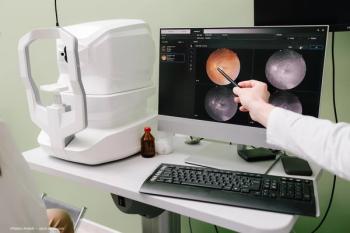
- Ophthalmology Times: July/August 2025
- Volume 50
- Issue 4
Seeing the unseen: Improving early detection for patients with MacTel
Key Takeaways
- MacTel is a progressive neurodegenerative disease causing central vision loss, with Müller glial cell and photoreceptor abnormalities. Early symptoms are subtle, complicating diagnosis.
- Misdiagnosis is common, often confused with macular hole or age-related macular degeneration. Routine vision tests may not reveal the true extent of impairment.
Advanced imaging and awareness of systemic risk factors are essential.
Macular telangiectasia type 2 (MacTel) is a progressive and bilateral neurodegenerative disease of the macula that can lead to irreversible central vision loss and functional impairment.1-3 It is characterized by abnormalities in the Müller glial cells, photoreceptors, and retinal pigment epithelium, as well as a progressive loss of the ellipsoid zone (EZ).4,5 Early symptoms of the disease typically include mild visual distortion, reading difficulties, reduced contrast sensitivity, and scotomas.3,6 Although symptoms may be subtle at disease onset, their severity and impact on visual function typically increase with time.3
In addition to the initial subtlety of presenting symptoms, several other factors contribute to the diagnostic challenges of MacTel, including low awareness of the disease among both patients and clinicians.1,6 MacTel is frequently misdiagnosed as macular hole, age-related macular degeneration, or diabetic macular edema.7 Lastly, routine vision testing may not be sufficient to reveal the existence and severity of the condition, as visual acuity may not reflect the true extent of vision impairment in patients with MacTel.2
Until recently, there was no treatment approved by the FDA to slow the progression of MacTel in adults.8,9 Previous management strategies have included off-label and experimental options, such as intraocular steroid injections, focal laser photocoagulation, and anti-VEGF therapy (for neovascularized cases). However, these treatment approaches have not been found to impact visual outcomes for the nonproliferative stage of MacTel.10-13 Understanding the limited evidence and lack of clear benefit from previous therapies, the approval of revakinagene taroretcel-lwey (Encelto; Neurotech Pharmaceuticals, Inc) for adults with MacTel type 2 marks a significant advancement, highlighting the need for greater recognition of the condition and timely therapeutic intervention.8,9
Factors affecting diagnosis
Another potentially obscuring factor surrounding diagnosis is the variable presentation of MacTel, owing to variation in EZ loss and a nonlinear rate of disease progression. Although most patients experience a slow decline in visual function over time (often decades), others may experience rapid vision loss, particularly when the disease encroaches on the foveal center. High variability has even been demonstrated between fellow eyes, perhaps due to the nonlinearity of the EZ break area progression rate.14 A deeper understanding of the spectrum of progression is essential for timely and accurate diagnosis.
Several systemic comorbidities are associated with MacTel and may be helpful in identifying patients with an elevated risk of developing MacTel.15 For instance, diabetes mellitus is a known comorbidity, and it has been suggested that MacTel may be associated with abnormal glucose metabolism. There is also a significantly increased prevalence of obesity, hypertension, and a history of cardiovascular disease in patients with MacTel vs in same-aged peers. Given that telangiectatic vessels are a hallmark fundus finding in MacTel, the association of these systemic diseases and abnormal vasculature may point to a shared pathophysiology.
Although these comorbidities do not have definitive diagnostic utility, they may help suggest the existence of MacTel if the diagnosis is otherwise unclear. Future research is needed to improve the understanding of the condition’s pathogenesis and to clarify the relationship between MacTel and systemic disease.
The evolution of diagnosis
Historically, diagnosis has been based on clinical examination demonstrating several macular alterations, such as parafoveal graying, pigment migration, and telangiectatic vessels, but the latter 2 signs often do not appear until later in the disease course.5 The diagnostic process has since evolved over time with the advent of multimodal imaging. In particular, spectral domain optical coherence tomography (SD-OCT), OCT angiography (OCTA), and fundus autofluorescence play a critical role in diagnosis of the disease.5,7
On SD-OCT, characteristic inner retinal cavitations and EZ layer loss can be seen.5 OCTA may reveal telangiectasias and right-angled venules, abnormalities that may be detected early in the disease course.7 Fundus autofluorescence can show the classic oval hypoautofluorescence zone temporal to the fovea, a change that often precedes detection with other imaging modalities.5 The importance of understanding the imaging modalities used to diagnose MacTel is amplified by the emergence of an FDA-approved treatment.
The first FDA-approved treatment for MacTel
Revakinagene taroretcel-lwey, an intraocular implant that utilizes encapsulated cell therapy, was approved in March 2025 for the treatment of adults with MacTel.8,9 Encapsulated cell therapy uses genetically modified retinal pigment epithelium cells to express therapeutic proteins—in the case of revakinagene taroretcel-lwey, ciliary neurotrophic factor (CNTF).8,9,16 In situ protein synthesis enables long-term release into the vitreous upon surgical implantation. Upon its release, CNTF initiates a signaling cascade targeting the Müller glial cells that promote photoreceptor survival.8,9,16
A subanalysis of clinical trial data revealed that patients with smaller EZ area loss (< 0.5 mm2), younger than 65 years, or with no foveal involvement at baseline had a greater likelihood of achieving a response with revakinagene taroretcel-lwey (ie, greater preservation of EZ area).17 In other words, those with less advanced disease were more likely to have a positive treatment outcome, demonstrating the importance of early diagnosis and treatment to preserve photoreceptor function.
Revakinagene taroretcel-lwey is contraindicated in patients with active or suspected ocular or periocular infections or known hypersensitivity to endothelial serum-free media. For more details, refer to the important safety information.9
Improved clarity on the presentation and disease progression of patients with MacTel will be needed to determine the best candidates for treatment. Most affected patients will likely be eligible for treatment, especially those in the earlier stages of disease. Many patients have worse disease severity in one eye than the other, which may necessitate some deliberation to determine whether to implant the better- or worse-seeing eye first. Although more postapproval data are necessary to determine positive and negative prognostic factors, we can expect that excessive pigment or scarring may limit the efficacy of the implant.
Given the typically slow progression of disease, comfort may play a larger role than visual considerations in determining the first eye to implant for patients with bilateral disease, particularly if both eyes receive implantation within a few months of each other. Patients should be counseled on the expected outcomes of treatment (ie, slowing but not reversing disease progression), and the significance of the EZ break for treatment candidacy, including the location, appearance, and relevance of its proximity to the fovea, to ensure they are fully informed and involved in their health care decisions.
Conclusions
With the recent FDA approval of the first treatment for MacTel in adults, early and accurate diagnosis has never been more critical. Clinical trial results have shown that earlier treatment is associated with greater efficacy in slowing disease progression. Yet, timely diagnosis is complicated by the subtlety of early symptoms, the frequency of misdiagnosis, and the diagnostic insufficiency of routine vision testing. A greater understanding of the variable presentation of MacTel and its association with certain systemic comorbidities may help improve the diagnostic process. Although this recent regulatory approval marks a major milestone in MacTel, the path to treatment is just beginning to be forged.
Sophie J. Bakri, MD
E: [email protected]
Bakri is professor and chair of the Department
of Ophthalmology at Mayo Clinic in Rochester, Minnesota. She maintains an active clinical practice and is involved in clinical and translational retina research. Bakri is a consultant for Neurotech Pharmaceuticals, Inc, and has received funding from Neurotech Pharmaceuticals, Inc, for clinical trial research, as well as funding from The Lowy Medical Research Institute.
References
Krivosic V, Dobbels Z, Duliere C, Zureik A, Tadayoni R, Gaudric A. Multilayer retinal correspondence of the structural and vascular anomalies in eyes with early macular telangiectasia type 2. Invest Ophthalmol Vis Sci. 2024;65(11):24. doi:10.1167/iovs.65.11.24
Clemons TE, Gillies MC, Chew EY, et al. The National Eye Institute Visual Function Questionnaire in the Macular Telangiectasia (MacTel) Project. Invest Ophthalmol Vis Sci. 2008;49(10):4340-4346. doi:10.1167/iovs.08-1749
Heeren TF, Clemons T, Scholl HP, Bird AC, Holz FG, Charbel Issa P. Progression of vision loss in macular telangiectasia type 2. Invest Ophthalmol Vis Sci. 2015;56(6):3905-3912. doi:10.1167/iovs.15-16915
Newman E, Reichenbach A. The Müller cell: a functional element of the retina. Trends Neurosci. 1996;19(8):307-312. doi:10.1016/0166-2236(96)10040-0
Wu L. Multimodality imaging in macular telangiectasia 2: a clue to its pathogenesis. Indian J Ophthalmol. 2015;63(5):394-398. doi:10.4103/0301-4738.159864
Simunovic MP, Hess K, Gillies MC. Impairments in cone pigment regeneration and absolute threshold in macular telangiectasia type 2. Retina. 2022;42(3):569-575. doi:10.1097/IAE.0000000000003328
Moir J, Amin SV, Khanna S, et al. Use of OCT angiography to diagnose and manage atypical presentations of macular telangiectasia type 2. Int J Mol Sci. 2022;23(14):7849. doi:10.3390/ijms23147849
Albini TA. Phase 3, multicenter, randomized, sham-controlled studies of the efficacy and safety of revakinagene taroretcel in macular telangiectasia type 2. Presented at: Retina World Congress 2024; May 9-12, 2024; Fort Lauderdale, FL.
Encelto. Prescribing information. Neurotech; 2025. Accessed June 17, 2025. https://www.neurotechpharmaceuticals.com/wp-content/uploads/ENCELTO-PRESCRIBING-INFORMATION.pdf
Wu L, Evans T, Arévalo JF, et al. Long-term effect of intravitreal triamcinolone in the nonproliferative stage of type II idiopathic parafoveal telangiectasia. Retina. 2008;28(2):314-319. doi:10.1097/IAE.0b013e31814cf03e
Vaze A, Gillies M. Salient features and management options of macular telangiectasia type 2: a review and update. Expert Rev Ophthalmol. 2016;11(6):429-441.doi:10.1080/17469899.2016.1251311
Meyer-ter-Vehn T, Herzog S, Schargus M, Göbel W, Guthoff R. Long-term course in type 2 idiopathic macular telangiectasia. Graefes Arch Clin Exp Ophthalmol. 2013;251(11):2513-2520. doi:10.1007/s00417-013-2346-z
Sigler EJ, Randolph JC, Calzada JI, Charles S. Comparison of observation, intravitreal bevacizumab, or pars plana vitrectomy for non-proliferative type 2 idiopathic macular telangiectasia. Graefes Arch Clin Exp Ophthalmol. 2013;251(4):1097-1101. doi:10.1007/s00417-012-2150-1
Pauleikhoff D, Bonelli R, Dubis AM, et al. Progression characteristics of ellipsoid zone loss in macular telangiectasia type 2. Acta Ophthalmol. 2019;97(7):e998-e1005. doi:10.1111/aos.14110
Clemons TE, Gillies MC, Chew EY, et al. Medical characteristics of patients with macular telangiectasia type 2 (MacTel type 2) MacTel project report no. 3. Ophthalmic Epidemiol. 2013;20(2):109-113. doi:10.3109/09286586.2013.766757
Chew EY, Clemons TE, Peto T, et al. Ciliary neurotrophic factor for macular telangiectasia type 2: results from a phase 1 safety trial. Am J Ophthalmol. 2015;159(4):659-666.e1. doi:10.1016/j.ajo.2014.12.013
Data on file, 2024. Neurotech Pharmaceuticals Inc.
Articles in this issue
4 months ago
The future of imaging is out of this worldNewsletter
Don’t miss out—get Ophthalmology Times updates on the latest clinical advancements and expert interviews, straight to your inbox.













































